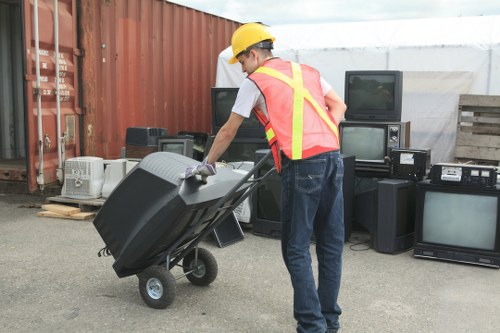Waste Clearance in Mega Waste: Efficient Solutions for Large-Scale Challenges
Understanding Mega Waste Clearance

In today's rapidly urbanizing world, the accumulation of waste has become a significant concern. Mega waste clearance refers to the large-scale removal and management of waste generated from industrial sites, commercial complexes, and densely populated urban areas. Efficient waste clearance is crucial for maintaining environmental sustainability, public health, and aesthetic appeal.
As cities expand, the volume of waste produced increases exponentially. Without proper waste management strategies, this can lead to severe environmental degradation, including soil contamination, water pollution, and air quality deterioration. Mega waste clearance addresses these challenges by implementing systematic and scalable waste removal processes.
Effective waste clearance not only involves the removal of waste but also its proper disposal, recycling, and, when possible, repurposing. This comprehensive approach ensures that waste is managed in an environmentally responsible manner, minimizing its impact on the ecosystem.
Key Components of Mega Waste Clearance

Successful mega waste clearance operations comprise several key components. Understanding these elements is essential for developing effective waste management strategies:
- Collection Systems: Efficient collection systems are the backbone of waste clearance. This includes the use of specialized vehicles and equipment to handle large volumes of waste.
- Transportation: Proper transportation logistics ensure that waste is moved from collection points to disposal or processing facilities in a timely and safe manner.
- Disposal Facilities: State-of-the-art disposal facilities equipped to handle various types of waste are critical for sustainable waste management.
- Recycling and Reuse: Incorporating recycling programs helps reduce the overall waste footprint by reusing materials and diverting waste from landfills.
- Regulatory Compliance: Adhering to local, national, and international regulations ensures that waste clearance operations meet environmental and safety standards.
Integrating these components effectively can lead to a more organized and efficient waste clearance process, reducing the negative impacts of waste accumulation.
Technologies in Mega Waste Clearance

Advancements in technology have revolutionized mega waste clearance operations. Modern technologies enhance the efficiency, safety, and sustainability of waste management:
- Automated Sorting Systems: These systems use sensors and AI to sort waste materials accurately, increasing the efficiency of recycling efforts.
- GPS Tracking: GPS technology allows for real-time tracking of waste collection vehicles, optimizing routes and reducing fuel consumption.
- Waste-to-Energy Plants: These facilities convert non-recyclable waste into energy, providing a sustainable alternative to traditional disposal methods.
- Smart Bins: Equipped with sensors, smart bins monitor waste levels and communicate with collection services to schedule pickups when necessary.
- Drones: Drones can be used for monitoring waste sites, identifying illegal dumping activities, and managing large-scale waste clearance operations.
The integration of these technologies not only streamlines waste clearance processes but also contributes to environmental conservation by reducing the overall waste footprint.
Challenges in Mega Waste Clearance

Despite the advancements in waste management, mega waste clearance faces several challenges:
- Logistical Complexities: Coordinating the collection, transportation, and disposal of large volumes of waste requires meticulous planning and execution.
- Resource Allocation: Allocating sufficient resources, including manpower, equipment, and funding, is essential for effective waste clearance.
- Environmental Regulations: Navigating the complex web of environmental laws and regulations can be challenging, especially when operating across different jurisdictions.
- Public Participation: Ensuring community participation and cooperation is crucial for the success of waste clearance initiatives.
- Financial Constraints: Funding large-scale waste management projects can be a significant hurdle, particularly in regions with limited financial resources.
Addressing these challenges requires a multifaceted approach that includes strategic planning, stakeholder collaboration, and the adoption of innovative technologies.
Strategies for Effective Waste Clearance

To overcome the challenges associated with mega waste clearance, various strategies can be implemented:
- Comprehensive Planning: Developing detailed waste management plans that account for all aspects of waste clearance is fundamental to success.
- Public-Private Partnerships: Collaborating with private entities can provide additional resources and expertise to bolster waste management efforts.
- Community Engagement: Educating and involving the community fosters a collaborative environment, enhancing the effectiveness of waste clearance operations.
- Investment in Technology: Leveraging the latest technologies can significantly improve the efficiency and sustainability of waste management processes.
- Regulatory Compliance: Ensuring adherence to all relevant regulations not only avoids legal issues but also promotes environmentally responsible practices.
Implementing these strategies can lead to more efficient and sustainable mega waste clearance operations, ultimately contributing to healthier and cleaner communities.
Environmental and Social Benefits

Effective mega waste clearance offers numerous environmental and social benefits:
- Reduced Pollution: Proper waste management minimizes soil, water, and air pollution, protecting ecosystems and public health.
- Resource Conservation: Recycling and reusing materials conserve natural resources and reduce the demand for raw materials.
- Job Creation: The waste management sector creates employment opportunities, contributing to economic growth.
- Improved Public Health: Reducing waste accumulation lowers the risk of diseases associated with poor sanitation and environmental contamination.
- Aesthetic Enhancements: Clean and well-maintained environments enhance the quality of life for residents and make areas more attractive to visitors and businesses.
By addressing waste clearance comprehensively, communities can achieve a healthier and more sustainable future.
Case Studies: Successful Mega Waste Clearance Projects

Several cities and regions have implemented successful mega waste clearance projects that serve as models for others:
- Singapore's Zero Waste Masterplan: Singapore has developed an ambitious plan aiming for zero waste, incorporating high recycling rates and advanced waste-to-energy technologies.
- Tokyo's Comprehensive Waste Management: Tokyo employs a detailed waste separation system and extensive public education programs to maintain low landfill usage.
- San Francisco's Recycling Programs: San Francisco has achieved high recycling rates through robust policies, community involvement, and innovative technologies.
- Sydney's Waste-to-Energy Initiatives: Sydney utilizes waste-to-energy plants to convert non-recyclable waste into electricity, reducing landfill dependence.
- Copenhagen's Green City Initiatives: Copenhagen integrates waste management with its green city initiatives, focusing on sustainability and environmental preservation.
These case studies highlight the importance of strategic planning, community engagement, and technological innovation in achieving effective mega waste clearance.
The Future of Mega Waste Clearance

The future of mega waste clearance lies in continuous innovation and sustainable practices. Emerging trends and future directions include:
- Circular Economy: Transitioning to a circular economy model where waste is minimized, and materials are continuously reused and recycled.
- Advanced Recycling Technologies: Developing new recycling methods that can handle a wider range of materials more efficiently.
- Smart Waste Management Systems: Implementing IoT-driven smart systems for real-time monitoring and management of waste streams.
- Public Awareness Campaigns: Increasing public awareness and participation in waste reduction and recycling initiatives.
- Policy Innovations: Crafting forward-thinking policies that incentivize sustainable waste management practices and penalize non-compliance.
Embracing these future trends will enhance the effectiveness of mega waste clearance efforts, ensuring they remain viable and sustainable in the long term.
Conclusion: Achieving Sustainable Waste Management

Waste clearance in mega waste scenarios is a complex but manageable challenge. By integrating comprehensive planning, advanced technologies, strategic partnerships, and community engagement, effective waste management systems can be established. These systems not only address the immediate issues of waste accumulation but also contribute to broader environmental and social goals.
As urban populations continue to grow, the importance of sustainable waste management will only increase. Investing in innovative solutions and fostering a culture of responsibility are essential steps towards achieving a cleaner, healthier, and more sustainable future.
Contact us today to learn more about our waste clearance services and how we can help your community manage waste efficiently and sustainably.
FAQs About Mega Waste Clearance

1. What is mega waste clearance?
Mega waste clearance refers to the large-scale management and removal of significant volumes of waste generated from industrial, commercial, and densely populated areas.
2. Why is waste clearance important?
Proper waste clearance is essential for environmental sustainability, public health, and maintaining the aesthetic appeal of communities.
3. What are the key components of effective waste clearance?
The key components include efficient collection systems, transportation logistics, disposal facilities, recycling programs, and regulatory compliance.
4. What technologies are used in mega waste clearance?
Technologies such as automated sorting systems, GPS tracking, waste-to-energy plants, smart bins, and drones are commonly used to enhance waste management processes.
5. How can communities participate in waste clearance efforts?
Communities can participate by following waste segregation protocols, reducing waste generation, participating in recycling programs, and supporting local waste management initiatives.
Get Started with Your Waste Clearance Project

Embarking on a mega waste clearance project requires expertise, resources, and a strategic approach. Whether you're managing an industrial site, a commercial complex, or a large residential area, professional waste clearance services can provide the necessary support to ensure your project is successful.
Our team of experienced professionals is equipped with the latest technologies and methodologies to handle all aspects of waste management. From initial planning to final disposal, we offer comprehensive solutions tailored to your specific needs.
Book your service now and take the first step towards a cleaner and more sustainable environment.